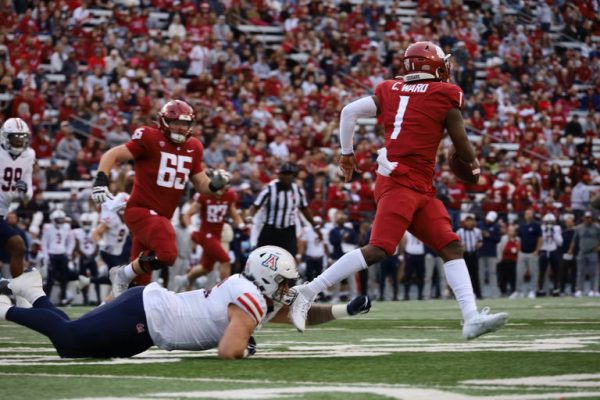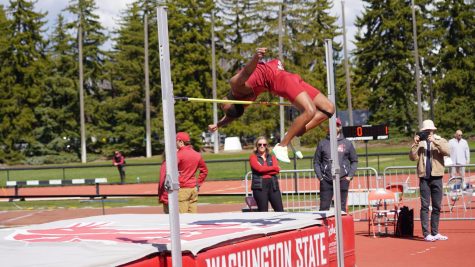Athletics budget looking up, thanks to Moos
Revenues from football ticket sales, donations to Cougar Athletic Fund grew under Moos
Courtesy of WSU Athletic Communications
Then Director of Athletics Bill Moos speaks to the gathered Cougar fans during the 2015-2016 Cougar Kick Off event.
October 24, 2017
The WSU community was blindsided by the shocking news that Athletic Director Bill Moos, a 1973 graduate of WSU, packed his bags last week and headed for Lincoln, Nebraska.
WSU Athletics certainly owes Moos a good portion of the credit for the program’s success. But it is what Moos left in the Palouse, rather than what he brought, that has many Cougars concerned.
In Moos’ seven-plus years here, he spent nearly half of it with the athletic department reporting annual deficits of more than $10 million.
WSU Athletics Chief Financial Officer Matt Kleffner helped contextualize the university’s situation. WSU has the lowest expenses and lowest revenues of all the schools in the power five conferences.
The institution is not overspending compared to its peers, but because of the small market in Pullman, its revenue is significantly lower.
“It is just the reality of where we live,” Kleffner said. “We are trying to minimize our expenses and maximize our revenues so we can be competitive. We aren’t trying to surpass anyone on the spending or revenue, we just want to be competitive with our peers.”
At face value, the situation may seem bleak, but Moos is a man who knows a thing or two about bringing athletics — particularly football — to the forefront of a university.
From 1995 to 2007, Moos was the athletic director for University of Oregon, where he helped lay the foundation for one of the most profitable athletic departments in collegiate sports today.
The blueprint is rather simple to explain: Get talented athletes. To get talented athletes, though, you need talented coaches. And to get talented coaches on board, you need to build facilities.
It is much easier to explain than carry out.
Kleffner added that we are beginning to see the investments start to pay off. The revenue from the football gates in fiscal year 2010 was less than $3 million. The athletics department projects more than $8 million in revenue from ticket sales this season from football alone.
The department has seen donations to the Cougar Athletic Fund (CAF) grow from less than $2.5 million in fiscal year 2010 to a projection of more than $7 million in fiscal year 2017, Kleffner said.
As of now, the plan is for the department to be solvent by fiscal year 2021. Although a couple wrenches have been thrown in the wheel on the way, the deficits that WSU has faced were a part of the plan.
The NCAA deregulated how a school feeds its athletes in 2014, which in turn cost the athletic department roughly $750,000, Kleffner said.
NCAA legislation changes are not part of WSU’s plan, and it is nearly impossible to account for unexpected changes. Kleffner said the plan to reach solvency is always being modified and updated to try to anticipate every possible expense and revenue.
This notion that the athletic department’s investments are irresponsible could not be farther from the truth. The reality is, Moos saved an athletic department that was collapsing from its infrastructure.
It may be awkward now that the architect for the blueprint is no longer here, but that does not determine whether it will be successful. If anything, it might speed up the process.
Despite everything Moos was able to do for WSU Athletics, he lacked in one major area: bringing in giant donations.
WSU President Kirk Schulz made it clear that CAF donations would be a priority upon his arrival to Pullman. He is rather familiar with large donations from his days at Kansas State University, where the athletic department ranked sixth in the nation in private donations in 2014-2015.
When push comes to shove, dollar signs will often tell the tale. And they most certainly do in collegiate athletics.





















